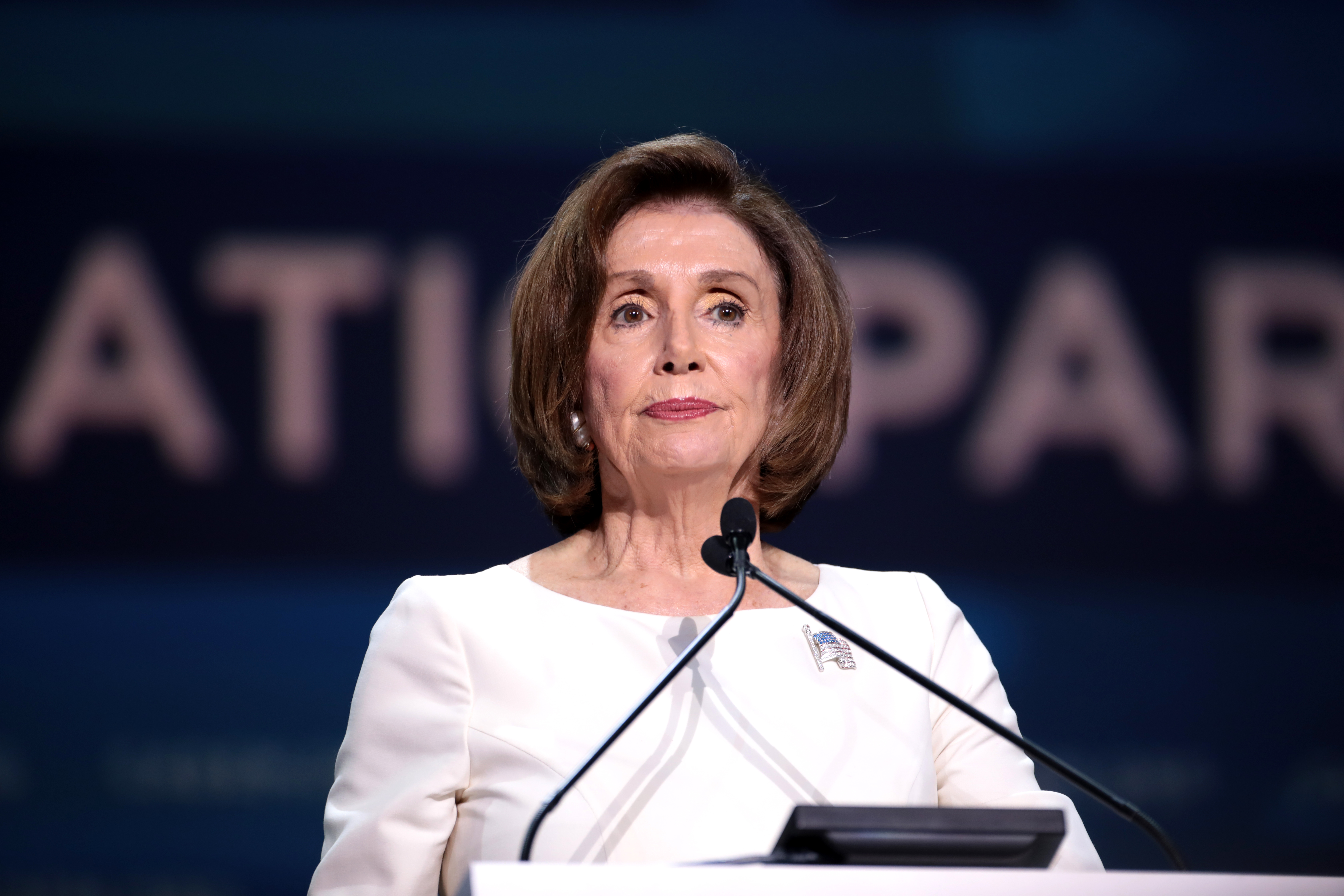Taking the Pelosi Attack Seriously
Coverage of the incident seems to have downplayed the significance of a kidnapping attempt and possibly even an assassination attempt against the speaker of the House, the woman third in line to the presidency.

Published by The Lawfare Institute
in Cooperation With

Of all the recordings of the violence on Jan. 6, some of the most disturbing video documents insurrectionists searching for Speaker of the House Nancy Pelosi. “Oh Nancy—where are you, Nancy?” one rioter calls out as he saunters through the building. It was a small moment, but watching as the House impeachment managers presented the clip during Donald Trump’s Senate trial, something about it made my skin crawl. As columnist Monica Hesse wrote in the Washington Post, the insurrectionist’s singsong tone—and the familiarity of referring to the speaker of the House just as Nancy—evokes a very particular kind of cruelty by men against women: “the sort of affectation a bad man might pick up after too many viewings of ‘The Shining.’”
It was hard not to think of that jeering search for Pelosi when news broke of the attack on the speaker’s husband on the night of Oct. 28. The assailant, David DePape, reportedly broke into the Pelosis’ San Francisco home with zip ties and duct tape in the middle of the night and demanded of Paul Pelosi, “Where is Nancy?” When police arrived, they witnessed DePape attacking the 82-year-old with a hammer, knocking him unconscious and fracturing his skull. Social media accounts and blogs seemingly belonging to DePape are filled with recent posts expressing hatred toward women, Jews, and Black people and adopting far-right conspiracy theories about the coronavirus and Jan. 6. He has been charged by the San Francisco district attorney with, among other charges, attempted murder. The Justice Department on Oct. 31 filed federal charges against DePape under 18 U.S.C. § 1201, the federal kidnapping statute, and 18 U.S.C. § 115, threatening or injuring a family member of a federal official.
Luckily, the attack was not fatal—the speaker’s office says that Paul Pelosi “is making steady progress on what will be a long recovery process”—and Nancy Pelosi herself was not there. But the incident represents an exceedingly close call. And yet, coverage of the incident seems to have downplayed the significance of a kidnapping attempt and possibly even an assassination attempt against the speaker of the House, the woman third in line to the presidency. The New York Times placed the story below the fold on the next day’s paper. On Twitter—which remains, for now, an influential hub for political journalists—debate over the implications of Elon Musk’s purchase of the platform well outpaced discussion of the Pelosi attack, at least until Musk tweeted and then deleted a link to a far-right conspiracy theory about the assault.
The attack on Paul Pelosi deserves greater attention, even in a frenetic media environment. It sits at the intersection of a number of concerning trends: rising political violence and violent rhetoric in the United States, particularly directed toward women, along with a right-wing media ecosystem that fuels that rhetoric and responds to violence by promoting further falsehoods.
Republicans have tried to play down the role of politics in DePape’s attack, but the Justice Department’s complaint shreds any argument that DePape’s attack was not politically motivated. According to the charging document, DePape informed the police questioners that he had planned to:
hold Nancy hostage and talk to her. If Nancy were to tell DEPAPE the “truth,” he would let her go, and if she “lied,” he was going to break “her kneecaps.” DEPAPE was certain that Nancy would not have told the “truth.” In the course of the interview, DEPAPE articulated he viewed Nancy as the “leader of the pack” of lies told by the Democratic Party. DEPAPE also later explained that by breaking Nancy’s kneecaps, she would then have to be wheeled into Congress, which would show other Members of Congress there were consequences to actions. DEPAPE also explained generally that he wanted to use Nancy to lure another individual to DEPAPE.
As extremism researcher J.M. Berger noted on Twitter, this arguably fits the FBI’s definition of terrorism: “the unlawful use or threatened use of violence committed against persons or property to intimidate or coerce a government, the civilian population, or any segment thereof, in furtherance of political or social objectives.”
DePape’s attack is the latest entry in a nasty trend. Threats and harassment of politicians and those in public-facing roles have been on the rise in recent years, not just for national political figures but also for local officials like election administrators and members of school boards. According to Seamus Hughes of the George Washington University Program on Extremism, a review of recent federal court cases concerning threats against public officials shows a “meteoric rise” in threats since 2016. Likewise, citing statistics from the Capitol Police, the New York Times writes that “[t]he number of recorded threats against members of Congress increased more than tenfold in the five years after Mr. Trump was elected in 2016 ... with more than 9,625 threats reported in 2021.”
In July 2022, a man with a gun harassed Rep. Pramila Jayapal (D-Wash.) outside her house. Sen. Susan Collins (R-Maine) told the Times in October, “What started with abusive phone calls is now translating into active threats of violence and real violence”—a danger not just for members of Congress, but for their staff as well, who are often the ones fielding or reporting threats. The same day that DePape attacked Paul Pelosi, a Pennsylvania man pleaded guilty to making violent threats against Rep. Eric Swalwell (D-Calif.). The man had spoken by phone with Swalwell’s staff and informed them that he intended to arrive at the congressman’s office with firearms and kill him.
Following the attack on Paul Pelosi, reporting has highlighted how Nancy Pelosi personally has become a figure of hatred on the right and a focus of violent rhetoric. She’s a major subject of attack ads by Republicans, and, according to the Times, is “now one of the most threatened members of Congress in the country.” Days after the attack, Republican political strategist Doug Heye penned a mea culpa in the Washington Post for his role in formulating attack ads against Pelosi personally during the 2010 midterms. The “Fire Pelosi” campaign run by Heye involved a website featuring “a picture of Pelosi engulfed in flames” and a tour bus that trundled across the country demonizing the speaker.
As with the threats against Collins and Jayapal, it’s difficult to disaggregate the obsessive hatred for Pelosi from the gender dynamics at play. Male members of Congress receive plenty of threats as well—as Swalwell’s case shows—but women are particularly vulnerable. A recent report by the Center for Democracy and Technology found that women of color running for office faced higher rates of sexist, racist, and violent abuse online. The New York Times has reported that lawmakers of color far outspent their colleagues on the Hill on security measures, suggesting they face an increased volume and seriousness of threats.
Political violence and threats are not the exclusive provenance of those on the American right. In June 2022, police arrested an armed man near the house of Supreme Court Justice Brett Kavanaugh after the man, Nicholas Roske, called 911 and explained that he was planning to assassinate the justice; the FBI has alleged that Roske texted a friend beforehand explaining that he planned to kill Kavanaugh in order to “stop roe v wade from being overturned.” GOP House whip Steve Scalise was seriously injured in a 2017 shooting at a baseball diamond by a gunman who had made social media posts supporting left-wing causes. In a recent New York Times review of threats received by members of Congress, the Times found that “more than a third” of threats were made by right-wing callers threatening Democrats or Republicans for opposing or insufficiently supporting Donald Trump; “nearly a quarter” of threats, though, were made by Democrats against Republicans.
But it is unavoidably true that violent rhetoric is both more prominent and widely accepted—even encouraged—within the Republican Party in the present moment. Polling suggests that a quarter of Republicans believe that the violence on Jan. 6 was justified. This approach to violence comes from the top: Trump, the de facto leader of the party, routinely engages in demonization of his opponents. After the Pelosi attack, some Republicans condemned DePape’s actions outright, but others took a different approach. Virginia Gov. Glenn Youngkin commented at a rally immediately afterward, “There’s no room for violence anywhere, but we’re going to send [Pelosi] back to be with him in California.” One far-right member of Congress posted a meme endorsing the same conspiracy theory promoted by Musk. Donald Trump Jr. made a crack about it as well. Kari Lake, the Republican nominee for governor of Arizona, joked before an approving crowd that “Nancy Pelosi, well, she’s got protection when she’s in D.C.—apparently her house doesn’t have a lot of protection.” Donald Trump himself chimed in with yet another conspiracy theory a few days later.
The GOP is sufficiently suffused with violent language, harassment, and conspiracy theories that even a horrific act of violence like DePape’s is easily subsumed back into that same toxic brew without anyone taking responsibility. (Republican Sen. Ted Cruz, of Texas, who first condemned the attack as “horrific,” later retweeted a post claiming that Republican rhetoric had no role in DePape’s actions.) Research by political scientists Lilliana Mason and Nathan Kalmoe suggests that calming words from political elites really can help pacify potential violence—but Republicans are taking the opposite approach.
There is simply no comparable dynamic in the elite echelons of the Democratic Party or on the left. In 2017, after reporters uncovered that the attacker who had shot Scalise had volunteered for the 2016 presidential campaign of Sen. Bernie Sanders (I-Vt.), Sanders announced on the Senate floor that he was “sickened” and that he “condemn[ed] this action in the strongest possible terms.” Following Nicholas Roske’s arrest for his planned attack on Kavanaugh, the White House stated that “threats of violence or attempts to intimidate judges have no place in our society.” Democratic political leaders didn’t jeer, post memes about guns and baseball diamonds, or manufacture conspiracy theories about the attack.
All of this makes for a political environment in which an attempt to kidnap the speaker of the House is shocking and appalling but not necessarily surprising. DePape does not seem to have been well; his recent blog posts, according to the Washington Post, include descriptions of a time when he was “suicidal” and an account of his communications with an invisible fairy. A review of his blog by the Post shows an obsessive interest in right-wing political rhetoric about, among other things, transgender people and election fraud. It’s difficult to pull apart the threads of mental illness and a tense political atmosphere. But perhaps DePape’s situation recalls that of Cesar Sayoc, the man who mailed pipe bombs to a number of high-profile Democrats in 2018. In a sentencing memo, Sayoc’s lawyer argued that his client, who was intellectually disabled, struggled to distinguish fact from fiction and had come to believe the conspiracy theories vilifying Democrats that he read on the internet and saw on Fox News.
The fact that Pelosi’s attacker appears to be mentally unwell—rather than, say, a committed far-right ideologue—might explain, in part, why the attack has received less attention than one might expect. Andrew Prokop, a senior politics correspondent at Vox, summarized this view as follows: “[T]here are a lot of disturbed loners out there who embrace various forms of conspiracy theories and occasionally act on them,” and greater conclusions can’t necessarily be drawn from their actions.
But an increase in ambient violent rhetoric, along with endorsement of conspiracy theories from seemingly credible sources, risks creating an environment where troubled people are encouraged toward acts of political violence just like Sayoc was. In his review of federal prosecutions over threats to public officials, Hughes found that “most”—though not all—defendants “tend to have mental health issues.” And as Lawfare foreign policy editor Dan Byman pointed out to me, plenty of attackers who carried out jihadist violence also turn out to have struggled with mental illness—but that usually doesn’t affect the willingness of politicians and the press to condemn their actions as terrorism.
Also contributing to the relatively quiet press coverage might be the fact that Nancy Pelosi herself wasn’t present and that Paul Pelosi will, according to the speaker, be fine. If the speaker or her husband were killed or kidnapped, one certainly hopes that the conversation around the incident would look very different. As it is, the attack risks fading into the broader societal numbness toward a level of political violence and harassment that would, even a few years ago, have been shocking.
In New York Magazine, Jonathan Chait writes that “[t]he personal vulnerability of Pelosi is a simple problem that we can, and very likely will, solve.” The speaker herself is protected by a security detail; her husband, without her present, did not enjoy such protection. According to Politico, members of Congress are considering the feasibility of increased security following the attack.
Chait goes on to warn that the real horror of DePape’s actions is not the attack itself but the possibility of something “much worse”: “the potential for political violence on a larger and more tragic scale than the attack on Pelosi’s home.” This is certainly true and deeply concerning. But I worry that there is a risk, in warning that this assault may portend something even worse down the line, of underplaying just how bad things are as they now stand. Americans have a tendency to situate all political violence against the benchmark of a “second civil war,” and the country is certainly not there yet. But even violence that remains below the level of a shooting war is corrosive in ways all its own. The Center for Democracy and Technology study, for example, reported that women of color who faced harassment when running for office generally agreed that the goal of such abuse was to drive them out of public life. When it becomes clear that the cost of a political career is the possibility of threats against your life and the life of your family—not to mention, in the wake of Jan. 6, serving alongside people who supported a cause that very well may have led rioters to kill you—how many people will decide they no longer want to be involved in politics?





